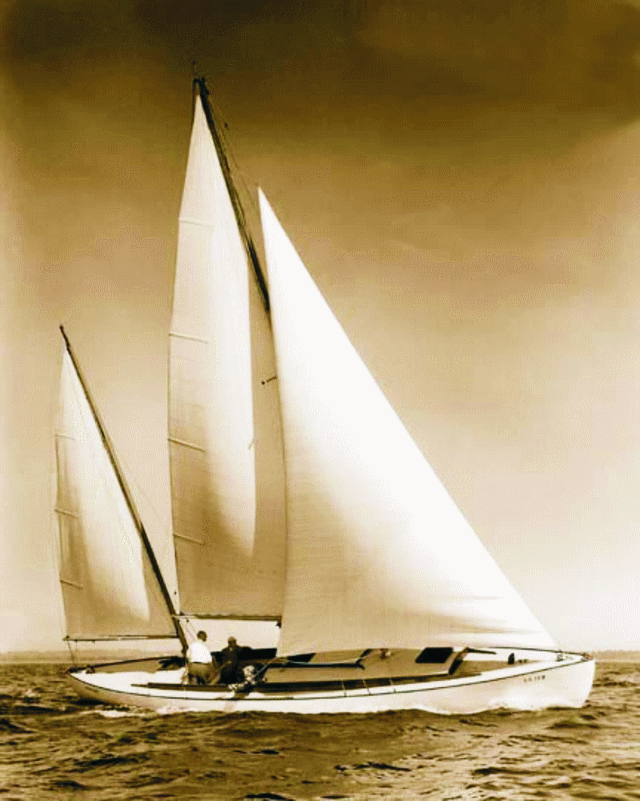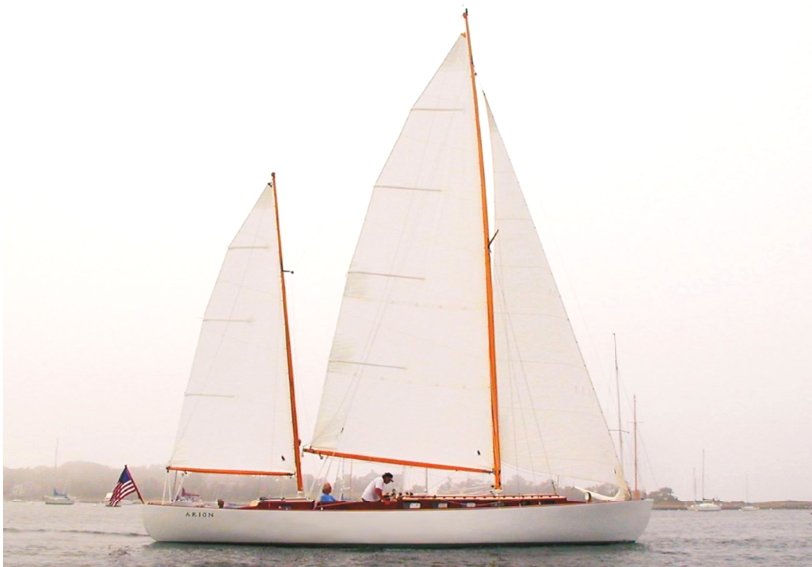
By Kay Harley
Above: ARION as she looked in 2001.
Damian McLaughlin, a custom boatbuilder from North Falmouth, Massachusetts, has been designing, repairing, and building boats for more than thirty years. Recently, he finished the reconstruction of Arion, heralded at its launch in 1951 as “The first auxiliary sailboat built with fiberglass,” and “The largest one-piece hull of reinforced plastic in the world.” In 1950, Sidney Herreshoff, son of the famous Nathaniel, designed the 42′ Arion to be built using what was then an innovative new material: plastic resin reinforced with glass fibers, otherwise known as fiberglass. The Anchorage Plastics Corporation built it in Warren, Rhode Island for Verner Z. Reed, Commodore of the Ida Lewis Yacht Club in Newport. Anchorage had been building wooden boats for over 25 years and then started working with fiberglass reinforced plastic in 1946. Prior to Arion, they had built over 500 fiberglass reinforced plastic boats, most 9 to 16 feet long, though also two 36-footers for the Navy and one 24-footer for the Coast Guard. Many were skeptical about the suitability of this new material in large craft. In order to reduce the loads and strains that were to challenge this vessel, Mr. Herreshoff elected to minimize the hull resistance so that Arion could be driven with a small rig, choosing a ketch rig to facilitate easy sail combinations for the 562 square foot sail area. A fin keel with lead at the bottom and a balanced rudder complemented the canoe hull shape. At the time, Arion developed a great reputation and was featured in the July 1951 Yachting Magazine. However, after some initial excitement, she faded from view.
Damian McLaughlin had known of Arion‘s existence for 25 years and relocated her, her hull apparently sound. He writes, “I was convinced to buy Arion when I first saw her in a field. She had about 2000 lb of water inside, and the poppets holding her up were so tight I couldn’t believe that she was not deformed. Her hull surface was cosmetically terrible and some amateurs had done their best to make her look even worse, but her sheer and general fairness had not been compromised. Her designer, Sidney Herreshoff, had a fine pedigree, and her sailing track record was quite good so I took a chance.”

“I soon learned that I had a marine archaeological treasure. My initial inspection revealed that in spite of the fact that Arion had been poorly kept, her structure and shape were in remarkably good condition. When I inspected with a moisture meter designed for fiberglass structures, there was no reaction except at the chainplates where I discovered little pockets of water where bondo-type stuff had encapsulated the chainplates. Extensive physical examination including core samples detected no delamination.”
“Arion is a yacht constructed of straight fiberglass laminate with no core materials. The skin thickness at the deck is ¼”± and gets thicker with 7/16″ at the turn of the bilge, ending with 2¼” at the keel attachment stub. The hull was built using only glass cloth, which seemed to be about 10 oz, but the weave pattern was very open. There is about as much open space between as in the bundles of glass strands. The reason for this, I believe, is that the resin (plastic) was supposed to be the primary building material and the fiberglass was only there to help with reinforcement. There was no gelcoat as we know it today, but there is a white pigmentation throughout the laminate with extra resin on the outside surface. Some very fine chopped mat was discovered inside at various places of extra reinforcement, but no one that I talked to could remember if it existed at that time. The plywood structure inside was very sparse and it was connected to the hull with a putty-like substance that is similar to Bondo®. It has remained very resilient to this day and soon clogged saw blades and required small pneumatic chisels for removal. There was no fiberglass tabbing as in present-day construction. The interior surface was much rougher than the exterior, similar to today’s construction. Chainplates are placed on the inside of the skin and through-bolted with flat-headed carriage bolts. Of the original internal structure only the sheer clamp, five small deck beams in the stern, two partial bulkheads, and two berth frames were worth saving.”
Damian McLaughlin approached the reconstruction of Arion with enthusiasm and a sense of expectation. While his company has built more than 70 small craft, cruising and racing designs, and multihulls since 1970, Damian has recently been limiting his projects to the use of wood and WEST SYSTEM® Epoxy products to recreate the best and most beautiful of the old Herreshoff (father and sons) designs. For the reconstruction, all Damian had for plans were a photocopied profile and sail plan from the 1951 article in Yachting Magazine. He also had photographs from Norman Fortier that were quite good and several 1951 newspaper articles. He took some offsets and hired a naval architect to recreate a lines plan, do the hydrostatic calculations, and develop a new 7/8 fractional rig sail plan.
Damian drew on his experience with WEST SYSTEM® products extensively in the reconstruction. At the start of rebuilding, the usable inventory consisted of a keel and deadwood with keel bolts, a hull with chainplates, 2 partial bulkheads, 2 partial bunk frames, 2 prop shaft struts for a single shaft, a rudder shaft with stuffing box and upper bearing, 6 deck beams in the stern, a serviceable sheer clamp lamination, and a solid wood mizzen mast and boom.
During reconstruction, the whole interior and exterior were stripped and ground, and sandblasted. Much of the interior was abraded with coarse-grit grinders and again inspected for delaminating or other problems. As Damian says, “The more that I dug into this vessel, the more confident I became that I had made a good decision to restore Arion to her former glory. I added four transverse bulkheads, two full-length longitudinal supports, as well as utilizing all the interior furniture components to reinforce a structure that had actually been tested at sea for 25 years.”
Using WEST SYSTEM products, the sheer clamp, five old deck beams, berth frames, and bulkheads were reinstalled. The companionway ladder was rebuilt and the original mast step and floorboards were used. New deck beams were installed with ½” plywood covered with 6 oz glass cloth. Damian replaced the main cockpit bulkhead and added bulkheads at the aft side and forward side of the aft cabin, as well as at the forward side of the main cabin. He also rebuilt the aft cabin and its double berth. The galley to port consists of a sink, stove, and refrigerator/cooler. A two-person settee is to starboard of the galley with port and starboard berths forward. There is a head with a hopper and sink at the forward end of the main cabin. There are also new water and fuel tanks. Throughout, Damian designed the interior furniture and shelves for utility, but also to add strength and stiffness to the structure while minimizing weight.
The entire deck, cabin sides, and cabin top were replaced. The new cabin sides are varnished mahogany. The decks are plywood covered with fiberglass and epoxy. The cockpit is new with seats and lockers. Topsides are painted with Awlgrip™. The bottom was barrier coated with WEST SYSTEM Epoxy.
The lead keel and deadwood on Arion were in near perfect condition, as were the thirteen 5/8″ monel keel bolts which showed absolutely no corrosion. The keel is a 4,400 lb lead casting that was placed at the bottom of two feet of yellow pine deadwood. The keel assembly was removed, inspected, and reinstalled using 3M 5200™ polyurethane sealant. The exterior deadwood surfaces were thoroughly sealed with WEST SYSTEM Epoxy.
New engine beds support a new Yanmar 2GM20 18-horsepower diesel engine. Two new rubber bearings were installed in the existing struts and a 15″ Max-prop was used on a new shaft. The balanced spade rudder is set well aft and is connected to the tiller with an offset linkage.
The new main mast and boom are Sitka spruce. Hardware includes Lewmar™ winches, Harken™ and Schaefer™ blocks, and custom bronze as well as several items that were salvaged from the original boat. All the windows in the cabins are “Goldenball” style opening ports. Three new sails for the 7/8 fractional rig are from Maine Sailing Partners.
Damian McLaughlin describes Arion‘s reconstruction as fun, saying he proceeded with a sense of expectation. “The June 2001 re-launching took place exactly 50 years from her first launching, on her 50th birthday. To me, it was the resurrection of antiquity, an archaeological excavation, and the assembly of what I thought to be the perfect combination for sailing/ cruising. I have been ecstatic over the discoveries of the attributes of this vessel learned while rebuilding her, getting her tuned, and just sailing her. She is very fast, with an easy motion; she sails herself with almost no input on the tiller, and she maneuvers inside the harbor like a 15’ daysailer.”
For more information visit Damian McLaughlin’s website.





